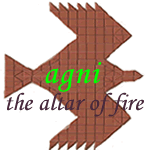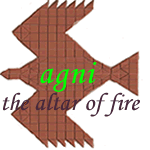|
|
|
|
The sizes of the ritual enclosure and of the main altars
are functions of the size of the Yajamana, and are sometimes identified with
him. The basic units, aratni and prakaram depend on the size of the Yajamana .The ritual
enclosure and altars thereby become his own . Standing with hands raised
above his head , the distance from the tips of his fingers to the ground is
copied on a measuring stick, subsequently divided into five equal parts. Each
fifth(panchami)is marked and determines the length of one aratni of his
altar. Next ,this panchami or aratni is divided into four equal parts. one is
added to the panchami , resulting in the sapudu, “with a quarter “ or ‘one
quarter added” which is at the same time chaturthi, one fourth of the length
of the Yajamana , and one prakrama of his altar The side of the basic square
bricks used in the construction of the main altar is one aratni or pancami. The Yajamana is again measured from the top
of his head to the ground while standing . This distance is divided into
three and again to seven equal parts. The resulting unities provide the
lengths of the two sides of the rectangular bricks needed for the new
domestic altar. Lastly , the distance is measured from the Yajmanas’s knees
to the ground .This again divided into five equal parts each called ‘muttu’one such unit determines the
thickness of the bricks of the domestic and the offering altar. The final
altars will therefore reach upto the knees of the Yajamana. The new domestic altar will be constructed
from 105 bricks , equally
distributed in five square layers, each of which consists of 3 X 7 rectangular bricks, all these
bricks are of same size. The main , bird-shaped offering altar
consists of bricks of various rectangular & triangular shapes. The total
number of bricks is 1000:200 for each of the five layers. There is three tradition of altar construction
. Two of these are called after the number of tips of the wings of the
bird—Panchapatrika (five tipped),satapatrika (six- tipped ). At the 1975 performance , the second one was
adopted . In this tradition , there are ten types of bricks , and the basic
unit is a square panchami or
arathi. The other shapes are derived from the basic square by adding and
subtracting. |
|
|
|
|
|
|
|
|
|
|
|
|
Copyright
2001 © Comp & Wilton Technologies |
|


